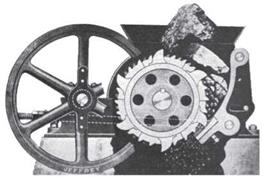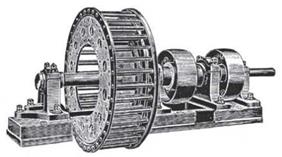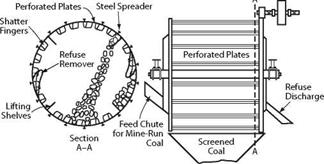The main uses of coal are as fuel in furnaces and as a chemical to reduce iron oxides to iron. To meet environmental standards for these purposes, coal needs to be mined, crushed, separated by size, upgraded, and ground to burn efficiently with the gaseous and solid wastes. Ground limestone is also required to remove hydrogen sulfide from the stack gases from the boiler. Shale and minerals are separated from the coal during breakage and can be rejected, particularly pyrite, so that a cleaner grade of coal can be burned in the boilers. Coal crushers changed little during the 20th century, and three types of machines are still in common use:
■ Conventional high — or low-speed crushers to break run-of-mine coal to pass a size that may be up to 150 mm, depending on the next process
■ Drums in which the coal is lightly broken to separate the shale and minerals from the coal macerates so that the macerates can be concentrated and make a high — quality coal for use in coke ovens
■ Roller mills and ball mills in which very fine particles are produced for combustion in boilers
Slow-speed single rolls with long and short teeth rotating at about 200 rpm have been used for the coarse-crushing run-of-mine coal since early in the 20th century (see Figure 5.21). Two counter-rotating toothed rolls may be used instead of one roll and a breaker plate.
The machine…gives a good cubical product of any size between 6 in. and 1.25 in. with a minimum of fines. …The segments have a combination of long and short teeth, the long feeder teeth gripping the large pieces and reducing them to a smaller size and which are finally reduced to the desired size by the short teeth.
Narrow slots in the shoe end of the breaker plate provide clearance for the long feeder teeth while allowing the breaker plate to be set close up to the roll to prevent oversize. …A 36 in. size breaker is capable of giving 500 tons of 8 in. coal or 155 tons of 1.25 in. coal per hour at 240 rpm utilizing 90 hp. (Lebeter 1949a)
Finer products could be obtained with higher-speed machines that used more power per ton, and the hammer mill became the first widely used high-speed crusher. It is particularly suitable for the fine crushing of softer, brittle solids and continues to be a leader in this field. “In the United States, impactor and hammer mills crushing coal normally are used to prepare the relatively fine crushed sizes used for charging coke ovens, feed to fine grinders and pipeline transportation” (Leonard 1991).
Carr’s disintegrator, shown in Figure 5.22, was devised at the end of the 19th century to crush coal to fine particles. This high-speed machine ran at 200 rpm, and had parallel discs rotating in opposite directions. The speed of the outer disc was up to 2,000 m/min. The discs had alternating annular rows of rods, three on one and two on the other, and material fed to the center of the machine was shattered by impact with the rods as it passed through them. Eventually, the fragments were small enough to pass through the outer ring. The machines ranged from 0.6-2.5 m in diameter, and the capacity of a 1.8-m mill using 15 kW was 15-30 tph of coal.
Slow-speed rolls produced coarse lumps that contained unliberated mineral matter and could only be roughly concentrated in jigs; high-speed crushers produced too many fines that were difficult to concentrate. Neither machine was ideal for preparing coking coal for concentration because removing mineral matter was very important.
The Bradford breaker was built in the late 1800s to break coarse lumps of mined coal for coke making (Figure 5.23). Still widely used for the purpose, it was invented by
|
|
|
FIGURE 5.21 Toothed roll crusher (Richards and Locke 1940)
|
|
FIGURE 5.22 Carr’s disintegrator, which was used for crushing coal (Louis 1909)
|
FIGURE 5.23 Bradford rotary breaker for coal (Richards and Locke 1940)
Hezekiah Bradford, but little is known about the inventor himself or the origin of the breaker.
The Bradford breaker consists of a rotary drum mounted on trunnions similar to a ball mill and rotates slowly at 12-18 rpm. The coal is raised by lifters attached to the inside wall of the cylinder of the drum and allowed to fall. The kinetic energy of the larger coal lumps is sufficient to shatter them when they hit the bottom of the drum, but the lumps of minerals and shale tend to resist breakage. The wall of the drum is made of screens, and the apertures allow particles that are small enough, usually about 50 mm, to leave the drum and proceed to further processing. The unbroken lumps of waste that do not pass through the apertures are removed through a refuse chute at the end of the drum. Abrasion breakage, which produces excess fines, is minimized, and no steel balls are used. About 80% of the macerates in typical coking coals can be broken into the size range of 1-50 mm and concentrated in dense-medium cyclones to produce high-quality coking coal.



